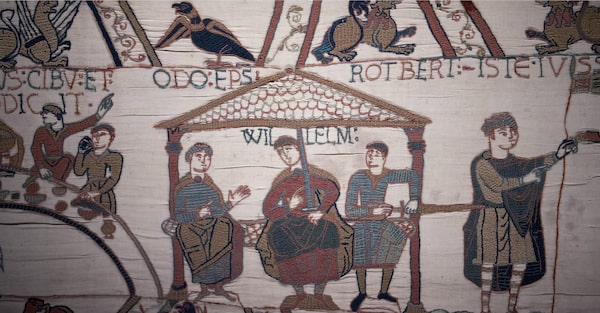
The Bayeux tapestry, which depicts Britain's conquest by William the Conqueror in 1066, pictured on Sept. 13, 2019, in Bayeux, France.LOIC VENANCE/Getty Images
The coronation of King Charles III on Saturday may elicit excitement or indifference, but regardless of one’s opinion of the ceremony there is one point on which all can agree: Charles is the one who wins the crown because of his ancestral lineage.
Some 28 generations up the current British monarch’s family tree is William of Normandy, who famously prevailed over his Anglo-Saxon opponent, Harold II, at the Battle of Hastings in 1066 and forever changed the course of English history.
For those preoccupied with or merely intrigued by genealogy, it’s an occasion to wonder exactly how much of the royal bloodline Charles has inherited. To put the question more scientifically, how much of William the Conqueror’s DNA is present in the genome of Charles?
The answer – which may come as a surprise to non-geneticists – is almost certainly none.
The reason does not involve any speculation about the paternity of those who preceded Charles on the long line from William. Rather it’s a matter of probabilities.
This point is succinctly explained by David Reich, a professor of genetics at Harvard Medical School, in his 2018 book Who We Are and How We Got Here.
As Prof. Reich points out, inheritance is diluted by the division and mixing of genes that occurs with each successive generation. You and everyone you know carries a mixture of DNA that came from two parents. Your parents, in turn, received that DNA from your four grandparents, who got it from your eight great grandparents, who got it from your 16 great, great grandparents, and so on.
Going back four generations, there remains a 100-per-cent chance that you are carrying at least some DNA from all 16 of those ancestors. As one goes further, however, the continued division of the genome means that some ancestors are lost in the mix. At 10 generations back you have 1,024 direct ancestors but only a 50-per-cent chance that you inherited DNA from any particular one of them. Going back 15 generations that probability falls to a mere 3 per cent. By 28 generations, the chance that any bit of William the Conqueror’s DNA survived the molecular relay and made it all the way down to Charles is vanishingly small.
Certainly, it’s possible to inherit DNA from an ancestor by more than one route, said Simon Gravel, who holds the Canada Research Chair in Statistical and Population Genetics at McGill University in Montreal.
As Dr. Gravel demonstrates in a recent study of Quebec’s French population, the majority of those who belong to that population group today are genetically descended from just 8,500 individuals, who came to Canada from France during the 17th and 18th centuries. Of those, the first 2,600 who arrived contributed to about two-thirds of the total Québécois gene pool.
Likewise, in the context of historic and modern England, it’s certain that Charles has many of the same genes that William the Conqueror did, which both would have been inherited from common ancestors reaching back over many tens of centuries.
But unless Charles has descended from William in thousands of different ways, “which seems unlikely even considering the high level of inbreeding in the British royal family,” Prof. Reich writes, it’s implausible to imagine that England’s first Norman king born nearly 1,000 years ago has left any trace in Charles today.
The remains of England's King Richard III which were found in a dig in Leicester, England, in September, 2012.The Associated Press
“My reasonably educated guess here would be that they would not be more closely related than any two British people because it doesn’t take a whole lot of mixing to make it such that everyone is related to everyone in a similar way,” Dr. Gravel said.
The two exceptions to this lies in the mitochondrial DNA that survives along the maternal line only, or in the Y-chromosomes that are passed from father to son. These change only gradually and can be linked back many generations. It was through a comparison of mitochondrial DNA, for example, that researchers were able to establish that a skeleton found under a parking lot in Leicester, Britain, in 2012 was genetically linked to known living relatives of King Richard III.
However, since Charles is descended from England’s medieval rulers through a combination of male and female ancestors, he has no such unbroken link back to those individuals, including William.
What does it mean for the legitimacy of the monarch today? In practical terms, nothing at all. Legally, inheritance is based on ancestry but not on the precise contents of one’s chromosomes.
But for those who are fascinated by famous ancestors – be it a king’s or their own – it’s worth remembering that such perceived connections may be less meaningful than they seem.
“Some people tend to take their ancestry very seriously, and they get encouraged to do that by ancestry testing companies,” said Dr. Gravel. “But as a geneticist, I try to encourage people not to put too much stock in these things because they tend to get overinterpreted.”
 Ivan Semeniuk
Ivan Semeniuk